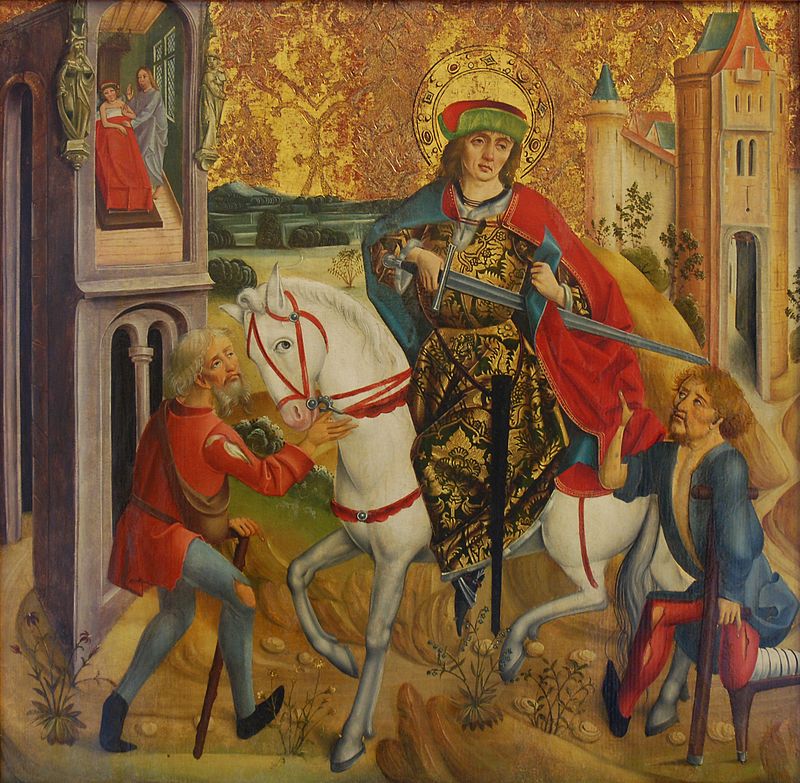
St Martin XV c
"St. Martin's Day – a goose and a jug of wine."
(Old Polish proverb)
Every Pole associates 11 November with Independence Day. But this day is also Martin’s name day, and in the Catholic Church the most important Martin is remembered - the bishop of Tours from the 4th century.
St. Martin was born in 317 or 335, in the Roman settlement of Colonia Claudia Savaria, the capital of the Danube province of Pannonia Superior (Upper Pannonia), situated on the Amber Road. Is seems most appropriate is to identify Savaria with the Hungarian town of Szombathely, just off the border with Austria.
His father, a Roman tribune, named his son Martinus after the god of war, Mars. Over the centuries, so many biographies and legends of Martin were created that today it is difficult to separate fact from myth. Everything we read about him should be marked with a default title "probably".
When Martin was a child, his father moved with the garrison to Pavia, Italy. There, our hero met Christians and at the age of 10 he became a catechumen. However, Martin’s family did not want to agree to his baptism. At the age of 15 he enrolled as a Roman legionary and two years later he took the oath. In 338 Martin together with his garrison went to Amiens in Galicia. One winter, when he met a half-naked beggar, he gave him half of his soldier's cloak. That night, Martin dreamed of Jesus wearing the half-cloak he had given away. He heard Jesus say to the angels: "Martin, clothed me with this robe". Martin was baptised in Easter 339, after which he resigned from his military service. The Christians of that time considered the profession of soldier, which was associated with killing, to be unworthy, so Martin left his legion. He went to Pannonia, to his parents, whom he converted to the Christian faith. For the next ten years he lived with dozens of other hermits in Ligugé, near Poitiers in western Gaul. He was famous for his virtues, ascetic life and miracles. In 360 he was ordained a priest and ten years later he became Bishop of Tours, a post he held until his death in 397. He often left his residence to preach the Gospel himself, established churches and visited Christian communities. He tried to atone for the sins of his faithful by living very modestly, wearing a sackcloth and fasting. When he died, his funeral was attended by – what at the time were - huge crowds of people. A Romanesque-Byzantine basilica was built over his grave in the 5th century. The day of Bishop Martin's funeral - 11 November - is celebrated as St. Martin's Day.
Few saints have been as popular as the Bishop Tours. Countless churches in the world bear his name. In France - of which he is the patron - there are over 4 thousand of them, in Poland over 200. The name of the saint was chosen by five popes, and the last one - Martin V (1417-1431) - was elected on 11 November.
St. Martin is the patron saint of the army, knights, soldiers, blacksmiths and armourers, travellers, refugees, beggars, shepherds, weavers, glove makers, vineyard owners, tanners, hoteliers and many others. The island of Martinique in the small Antilles took its name from the name of the saint as well as numerous springs of mineral waters. The figure of the saint is most often depicted as a legionnaire on a white horse, sharing half his coat with a beggar. To this day, in various parts of Germany, children's processions with "St. Martin's lanterns" take place, leading to the "St. Martin's bonfire". The children are accompanied by a knight dressed in a Roman helmet and a purple coat, which is supposed to remind us of the soldier Martin and his good deeds.
An analogous knight also leads the ceremonial parade on November 11th along the oldest street in Poznań - St. Martin. And here is an important remark. The name of the street is "St. Martin" and not "st. Martin’s" or "named after St. Martin", as visitors from outside Poznań often try to call it. This is a terrible mistake, which Poznań are loathe to forgive. Coming back to 11 November - on that day in Poznań special croissants are baked, filled with a white poppy seed paste and lots of sweet extras. In order to call a croissant Martin Croissants or St. Martin Croissants, the confectionery must obtain a certificate of the Chapter of Poznań Traditional St. Martin Croissant. On 30 October 2008, the St. Martin Croissant ['rogal świętomarciński'] name was entered in the register of protected designations of origin and protected geographical indications in the European Union. Since 2007, Caritas of the Poznań Archdiocese distributes croissants (in 2016 it was 20 000 pieces) and donates the collected funds to charity.
Another tradition links St. Martin to geese. When Bishop Tours died in 371, Martin was elected his successor. Not wishing to accept this office, he hid in the monastery shed where the geese were kept. The scared animals, however, raised an uproar, betraying Martin's hiding place. The new bishop was triumphantly introduced to Tours, and baking geese in remembrance of St. Martin became a permanent part of the Christian tradition as the last large meal before the six-week Advent fast.
So Americans eat turkey on Thanksgiving and Poles have a goose on National Independence Day.
Artur Karol
The author is a historian and publicist, an employee of the Institute of National Remembrance
